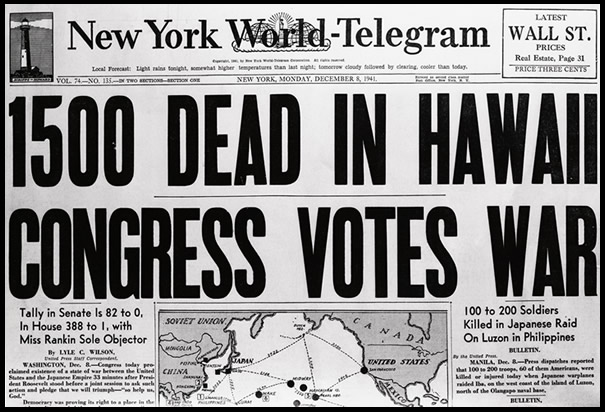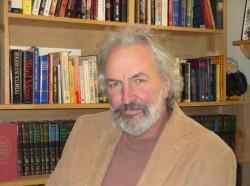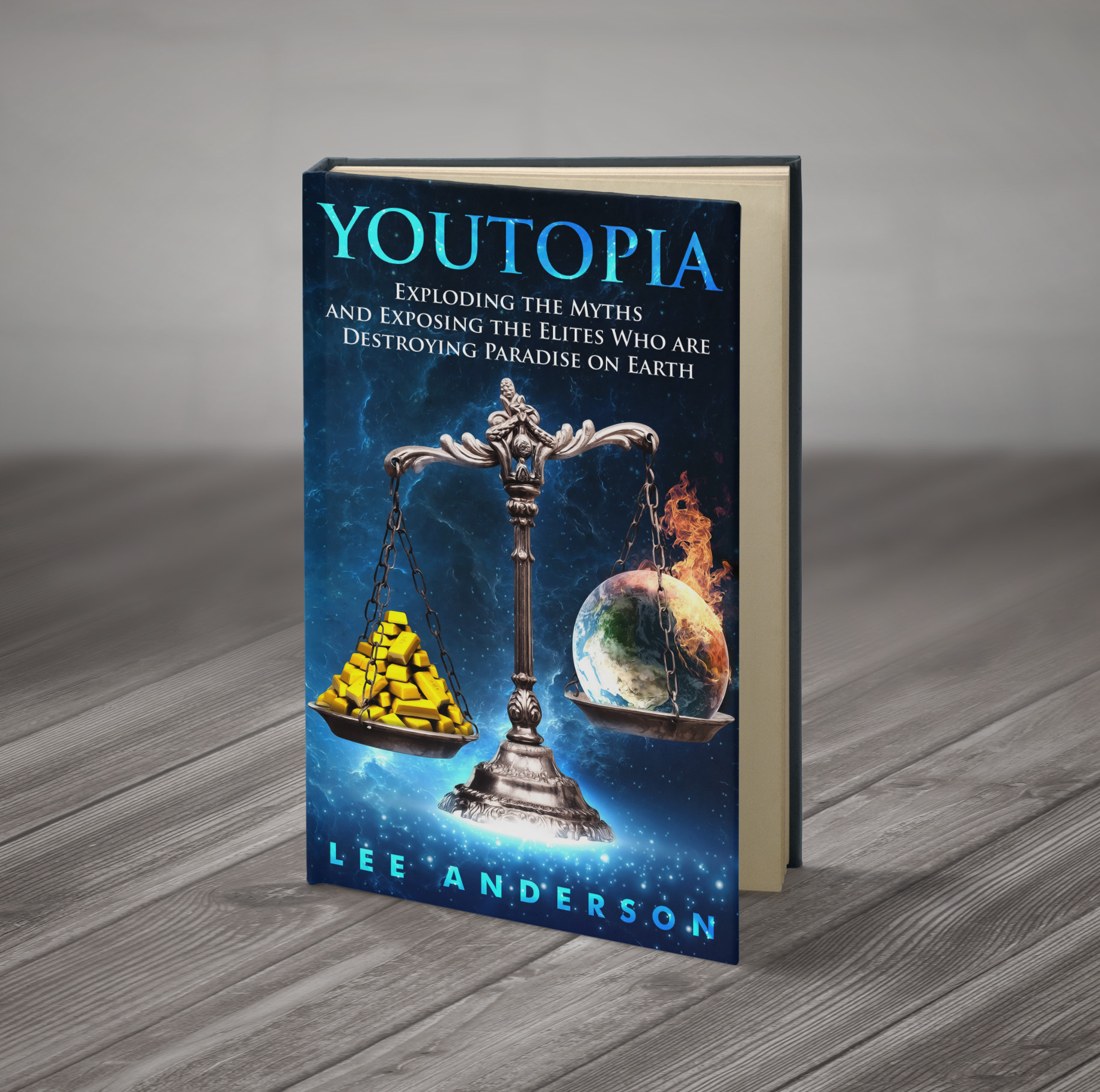Youtopia is dedicated to the proposition that our…
003 A New Pearl Harbor

Franklin Delano Roosevelt was correct in his address to the nation, to the world, the day after the Japanese attack on Pearl Harbor, Hawaii.
Yesterday, Dec. 7, 1941––a date which will live in infamy––the United States of America was suddenly and deliberately attacked by naval and air forces of the Empire of Japan. December 7th is a date that for sure will live in infamy.
The “unexpected” attack was a catalyzing and catastrophic event of such magnitude that it launched the U.S. into theaters of war against the Axis countries of Europe and the Pacific battles of East Asia; World War II never ended until two atomic bombs were dropped on Hiroshima and Nagasaki in August, 1945. And to this date, the United States remains the only country to use nuclear weapons against people of another country in a hostile action.
But Pearl Harbor is infamous for another reason, it has become synonymous with false flag events, the origins of the term false flag stems from the duplicitous practice of swashbuckling pirates of the Mediterranean and Caribbean flying the flag of a country or crown, hoping to lure in unsuspecting allies, then after the attack, replacing the flag with their Skull and Crossbones or Jolly Roger.
The instantaneous way in which the savage Japanese attack on Pearl Harbor dissolved, overnight, all opposition by U.S. citizens toward engaging the wars across the oceans is why today the phrase A New Pearl Harbor has become synonymous with false flag attacks. Pearl Harbor is considered to be one of many false flag attacks throughout history and many believe Roosevelt took unnecessarily harsh actions to isolate Japan, the island nation, dependent on imports, especially oil, from the world’s markets. The blockade left Japan, arguably, few options. Adding to overt provocation, many believe U.S. intelligence had broken Japanese encrypted codes, knew the Japanese Zeros were coming and chose not to alert officials at Pearl Harbor. But don’t take my word for it.
Robert Stinnett wrote a book about the controversy in 2000 titled: Day of Deceit: The Truth About FDR and Pearl Harbor. Stinnett served in the United States Navy from 1942 to 1946, where he earned ten battle stars and a Presidential Unit Citation. He is the author of George Bush: His World War II Years, he was a photographer and journalist for the Oakland Tribune. He is a consultant on the Pacific War for the BBC. A Publishers Weekly review of Day of Deceit provides a succinct overview.
Historians have long debated whether President Roosevelt had advance knowledge of Japan’s December 7, 1941, attack on Pearl Harbor. Using documents pried loose through the Freedom of Information Act during 17 years of research, Stinnett provides overwhelming evidence that FDR and his top advisers knew that Japanese warships were heading toward Hawaii. The heart of his argument is even more inflammatory: Stinnett argues that FDR, who desired to sway public opinion in support of U.S. entry into WWII, instigated a policy intended to provoke a Japanese attack. The plan was outlined in a U.S. Naval Intelligence secret strategy memo of October 1940; Roosevelt immediately began implementing its eight steps (which included deploying U.S. warships in Japanese territorial waters and imposing a total embargo intended to strangle Japan’s economy), all of which, according to Stinnett, climaxed in the Japanese attack. Stinnett, a decorated naval veteran of WWII who served under then Lt. George Bush, substantiates his charges with a wealth of persuasive documents, including many government and military memos and transcripts. Demolishing the myth that the Japanese fleet maintained strict radio silence, he shows that several Japanese naval broadcasts, intercepted by American cryptographers in the 10 days before December 7, confirmed that Japan intended to start the war at Pearl Harbor.
In support of the notion that all wars are banksters’ wars, it should be pointed out that Franklin Roosevelt, despite working with National City Bank chairman James Perkins to lay the foundation for the Glass–Steagall Act of 1933, a good thing, was also, according to Nomi Prins, author of All the Presidents’ Bankers, very friendly with the banksters.
Roosevelt socialized with bankers. He yachted with them. He was a Harvard graduate with solid blue–blood family connections, two townhouses in New York and a mansion overlooking the magnificent Hudson River. His presidency broke the chain of leaders from the Midwest and New England who did not grow up in the same social circles as the nation’s most powerful financiers. . . .
FDR’s father, James Roosevelt, had been a successful banker who traveled in the circles of J. P. Morgan and his ilk. The Rockefellers, Astors and Vanderbilts were all friends or neighbors of FDR.
Another friend and top financial advisor to Roosevelt was his brother–in–law Winthrop Aldrich, chairman of Chase National Bank. Winthrop was the son of Nelson Aldrich, the architect of the Federal Reserve Act of 1913. And it might also be interesting to some to learn that Rockefeller’s New Deal, strategist, John Maynard Keynes was once a director of the Bank of England, the bank that jump started the money creation monopoly by private banksters.
This is not to say that Roosevelt is evil or even that the New Deal was bad, it’s offered as proof of the interconnections among the highest political offices in the land and the financial royalists of the day, and if Pearl Harbor was indeed a false flag, then assuredly Rockefeller’s bankster friends were well aware of it and prepared to make a profit from the calamity, and indeed they did.
In my earlier blog post, 002 Mendacious Media, I offered a brief introduction to Zbigniew Brzezinski and included a quote from his book The Grand Chessboard; here is some lead up to his callous observation about the usefulness of catastrophic events. Following are some excerpts from Brzezinski’s Chessboard from pages 24-25 where he appears to lament somewhat that people have become more civilized.
The earlier empires were built by aristocratic political elites and were in most cases ruled by essentially authoritarian or absolutist regimes. The bulk of the populations of the imperial states were either politically indifferent or, in more recent times, infected by imperialist emotions and symbols. The quest for national glory, “the white man’s burden,” not to speak of the opportunities for personal profit—all served to mobilize support for imperial adventures and to sustain essentially hierarchical imperial power pyramids.
A genuinely populist democracy has never before attained international supremacy. The pursuit of power and especially the economic costs and human sacrifice that the exercise of such power often requires are not generally congenial to democratic instincts. Democratization is inimical to imperial mobilization.
The attitude of the American public toward the external projection of American power has been much more ambivalent. The public supported America’s engagement in World War II largely because of the shock effect of the Japanese attack on Pearl Harbor.
So are we to believe the references to Pearl Harbor are to impress the point that it takes a tragic, deliberate attack, something like a Pearl Harbor, in order to galvanize the public’s acceptance of war? Or, was it that coupled with the fact Pearl Harbor was arguably one of many false flag attacks in the history of war and pillage? When people today mention, “A New Pearl Harbor,” chances are good they are talking about a false flag operation.
One of the most recognized and respected writers and researchers on the most sophisticated false flag event ever, the September 11 attacks, is David Ray Griffin, a professor Emeritus of philosophy and theology at the Claremont School of Theology in California. Griffin titled his first influential book on the subject, The New Pearl Harbor, for all the reasons above and one other, perhaps far more telling reason, to bring attention to the very words from the Project for the New American Century, the PNAC neocons, many who filled out the ranks of the G.W. Bush Administration. A PNAC document from 2000 called Rebuilding America’s Defenses, discussed the geostrategic options around the world, or in pirate language, booty to plunder. Of course when you have influential people, strategizing, anticipating monumental world events, and then put them in political positions with which to facilitate those events, then you have something akin to insider trading with other people’s blood as collateral.
Below is an excerpt from Rebuilding America’s Defenses, and keep in mind, Jeb Bush, one of the PNAC neocons is running for president in 2016.
Any serious effort at transformation must occur within the larger framework of U.S. national security strategy, military missions and defense budgets. The United States cannot simply declare a “strategic pause” while experimenting with new technologies and operational concepts. Nor can it choose to pursue a transformation strategy that would decouple American and allied interests. A transformation strategy that solely pursued capabilities for projecting force from the United States, for example, and sacrificed forward basing and presence, would be at odds with larger policy goals and would trouble American allies.
Further, the process of transformation, even if it brings revolutionary change, is likely to be a long one, absent some catastrophic and catalyzing event—like a new Pearl Harbor.
Whenever we talk about war and the sacrifices people make we have to ask, what is it all for? The brave soldiers who died at Pearl Harbor and all subsequent New Pearl Harbors and in the wars that followed, all believe they are fighting for freedoms. Let’s make sure we all honor their sacrifices by not being afraid to engage in dialog and debate about any and all issues, whether these issues bring angst to very powerful people or not.

Lee is an author who lives with his wife and near his children and grandchildren in the Pacific Northwest, draws substance from a rather unique chapter in his lifestyle, raising a family in a remote wilderness valley in north central British Columbia. (lee@youtopia.guru) Find Out More >>












Leave a Comment